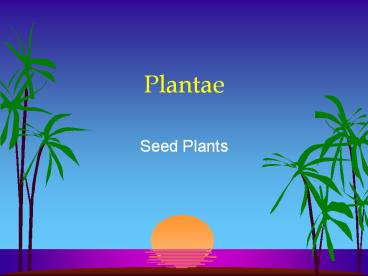Plantae - PowerPoint PPT Presentation
Title:
Plantae
Description:
Title: Biology 2 Author: Mark Joseph Cooper Last modified by: Mark Cooper Created Date: 7/14/1999 4:01:42 AM Document presentation format: On-screen Show – PowerPoint PPT presentation
Number of Views:138
Avg rating:3.0/5.0
Title: Plantae
1
Plantae
- Seed Plants
2
Vascular Plants
- Formation of vascular tissue
- Xylem (water)
- Phloem (food)
- True leaves, roots, and stems
- Lignin
- Sporophyte generation dominate
3
Alternation of Generation
4
Alternation of Generation
- Sporophyte dependent on gametophyte
- mosses
- Large sporophyte and small independent
gametophyte - ferns
- Gametophyte dependent on sporophyte
- seed plants
5
Why be Sporophyte Dominant?
- Reduced mutations
- UV light harmful to DNA
- Diploid (2n) form copes better with mutations
- two alleles
6
Why Retain Gametophyte Generation?
- Ability to screen alleles
- doesnt require a large amount of energy
- Sporophyte embryos rely on some gametophyte tissue
7
Seeds
- A seed is a sporophyte in a package
- spores are only single cells
- packaged with food
- All seed plants are heterosporous
- megasporangia
- microsporangia
8
From Ovule to Seed
9
Overview of Seed Plants
- Produce Seeds
- Can remain dormant for years
- Pollination replaces swimming sperm
- Gametophyte generation reduced
- Gymnosperms lack antheridium
- Angiosperms lack both archegonium and antheridium
10
Phylogeny
11
Gymnosperms(Naked Seed)
- Division Cycadophyta
- Division Ginkgophyta
- Division Gnetophyta
- Division Coniferophyta
12
Ginkgophyta
- Ginkgo or Maidenhair Tree
- Characteristic leaves
- Only one species
- Only males are planted
13
Cycadophyta
- Cycads
- Palm-like plants
- Sago Palms
- Leaves in cluster at top of trunks
- True Secondary growth
14
Gnetophyta
- 3 Genera
- Ephedra
- Mormon Tea
- Ephedrine
- raises heart rate
- raises blood pressure
15
Coniferophyta
16
Coniferophyta
- Pine tree is the sporophyte generation
- Contains both male and female cones
- Pollen (staminate) cones (low in tree)
- produces pollen
- Ovulate cones (high in tree) with scales
- produces seeds
17
(No Transcript)
18
Pine Life Cycle
- No Antheridium (microsporangia) produce pollen
grain (4 cells) - 2 prothallial cells
- 1 generative cell
- become a sterile cell and a spermatogenous cell
- produces 2 sperm
- 1 tube cell
- wings for dispersal
19
Pine Life Cycle
- Ovule in a ovulate cone
- integument (seed coat) (2n)
- megasporangia (meiosis) or nucellus (nutrition)
(2n) - produces 4 megaspores (3 die)
- develops into female gametophyte
- archegonium with eggs (n)
20
Angiosperms
21
Angiosperm
22
Flower
- Stamen
- Anther
- Filament
- Carpel
- Stigma
- Style
- Ovary with ovule
- Sepals
- Petals
- Receptacle
23
Angiosperm Life Cycle
24
Angiosperm Life Cycle
- No Antheridium (microsporangia)
- produce pollen grain
- 1 generative cell
- produces 2 sperm
- 1 tube cell
25
Angiosperm Life Cycle
- Ovule in Ovary
- megasporangia
- produces 4 megaspores (3 die)
- develops into female gametophyte called the
embryo sac
26
Angiosperm Life Cycle
- Inside embryo sac
- 7 cells (eight nuclei) due to 3 mitotic divisions
- 3 antipodals
- 2 polar nuclei (one cell)
- 2 synergids
- 1 egg
27
Angiosperm Life Cycle
- Double fertilization
- one sperm unites with egg
- one sperm unites with polar nuclei
- develops into endosperm (3n)
- Fruit and Seed development
- ovule seed
- ovary fruit
28
Cross Pollination
- Most flowers do not self-pollinate
- stamen and carpal may develop at different times
- stamen and carpal may be arranged in flower to
avoid contact
29
Angiosperm Radiation
- Begins the Cenozoic era (65 mya)
- Most closely related to the Gnetophyta
- Coevolution
- the mutual influence of two species on each other
- plants and animals (insects, birds, bats)
30
Pollination
31
Dispersal
32
The Global Impact
- Transformed atmosphere
- reduced carbon dioxide
- cooled the earth
- Nonrenewable resource































